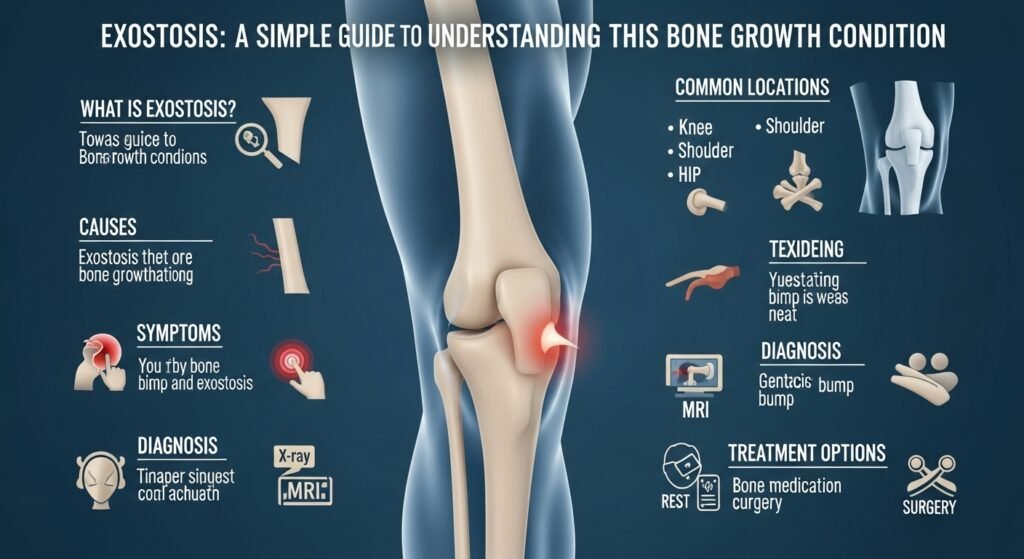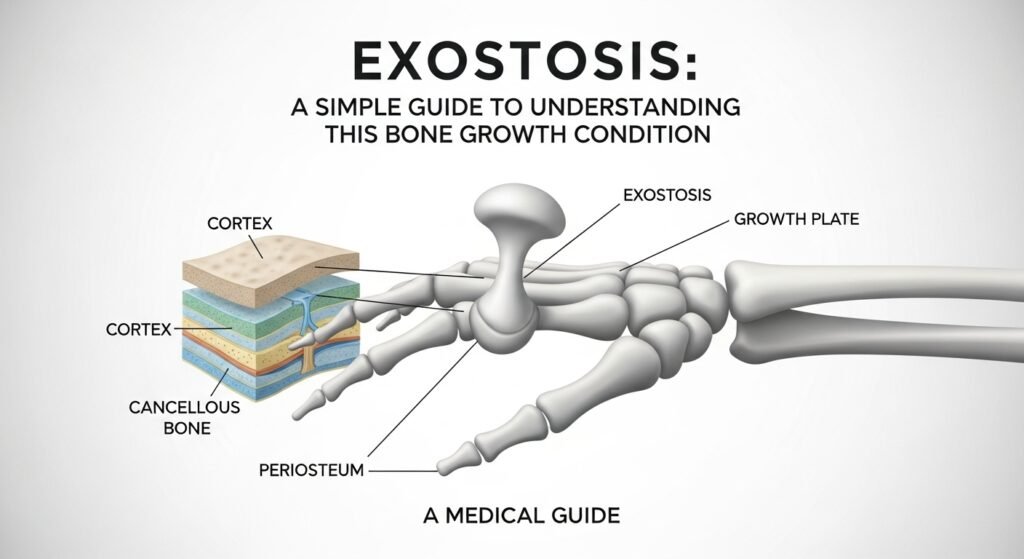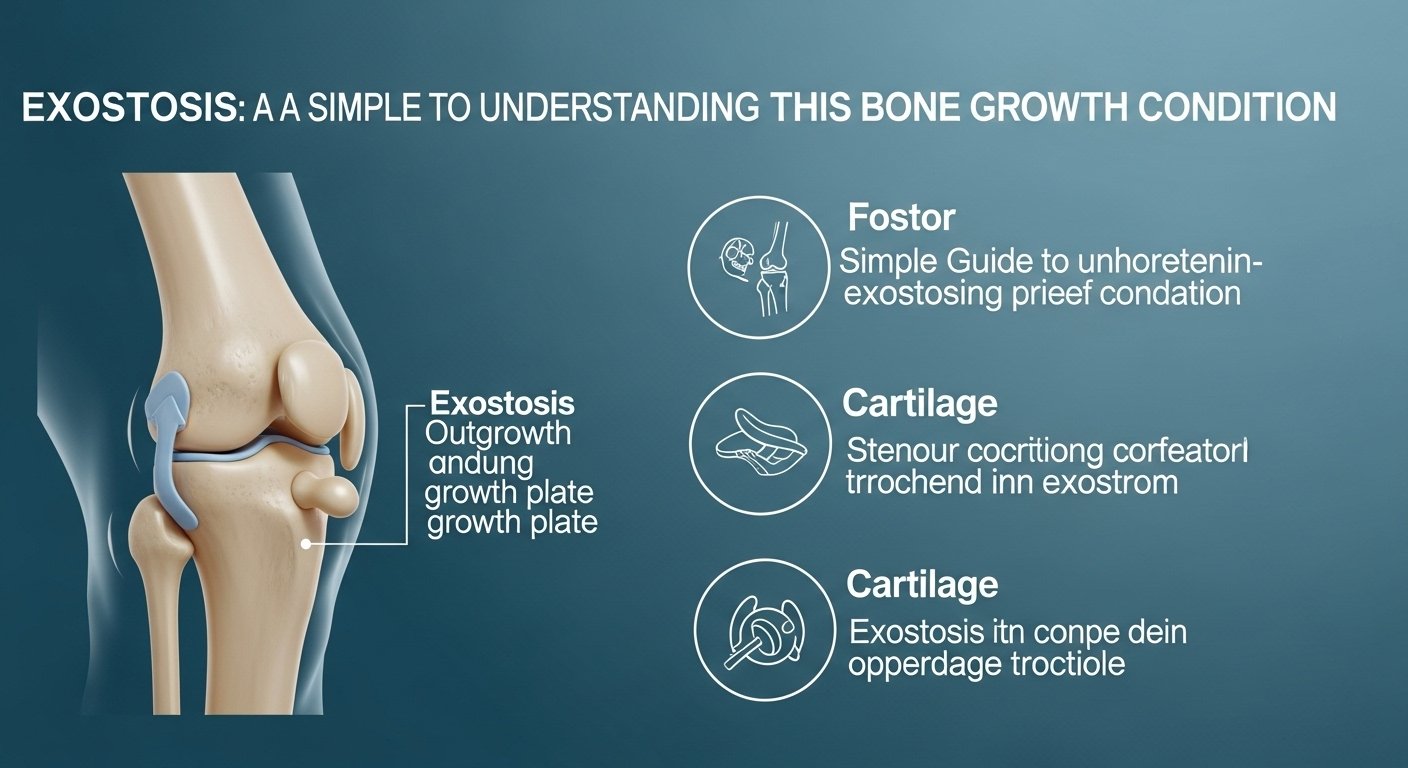Table of Contents
Have you ever noticed a small bump on a bone that feels hard but doesn’t really hurt at first? If so, it might be something called exostosis. This is a medical term for a bony growth that sticks out from the surface of a bone. It might sound scary, but in many cases, exostosis is harmless. Still, it can sometimes cause problems depending on where it grows and how big it gets. That’s why learning more about it matters, especially if you or someone you know has been told they have one. In this easy-to-read article, we’ll break down everything you need to know about exostosis: what it is, what causes it, how doctors find it, and what can be done if it causes pain or movement issues. Whether you’re a student doing research, a parent looking out for your kids, or just curious about your own body, this guide will help you understand exostosis in a clear and friendly way. Let’s dive in and explore what happens when your bones start growing in unexpected ways.
What Is Exostosis?
Exostosis refers to an abnormal growth of bone on top of a normal bone. Think of it as a little extra bump or lump made of bone tissue. These bony growths can appear on different parts of the body, like the jaw, ear canal, knee, or heel. Sometimes they grow slowly over time and go unnoticed until they start causing discomfort or begin pressing against something nearby, like muscles, skin, or nerves. While most exostoses (that’s the plural form) are non-cancerous, they should still be checked by a doctor to make sure they aren’t caused by another condition. Many people live with a small exostosis and never need treatment, though in some cases, removal is necessary.
Different Types of Exostosis
There are several types of exostosis, depending on where they appear and what causes them. One common type is osteochondroma, which usually appears near the growth plates of children and teens, often around the knee. Another type is subungual exostosis, which shows up under a toenail or fingernail and can cause pain or nail problems. Surfer’s ear, which we’ll talk more about later, is a form of exostosis in the ear canal caused by cold water exposure. There’s also buccal exostosis, found on the jawbone near the molars. Each type looks and feels different but they all have one thing in common—they’re made from bone growing in places where it typically shouldn’t.
What Causes Exostosis?
There are many causes of exostosis, and it often depends on the type. Some exostoses happen because of repeated stress or pressure on a bone over time. For example, people who swim or surf in cold water often get exostosis in their ear canals. This happens because the body reacts to the cold by growing more bone to protect those areas. Other times, the cause is genetic. This is the case with hereditary multiple exostoses, a rare condition where a person is born with the tendency to develop many bone growths. Injuries, infections, and inflammation can also sometimes lead to bone overgrowths that become exostoses.
Where on the Body Does Exostosis Appear?

Exostosis can grow in several places around the body. Some common areas include the ear canal (especially in surfers), the heel (often due to pressure from shoes), the spine, ribs, jaw, and under fingernails or toenails. In children and teens, it can form near the ends of long bones like the femur (thigh bone) or tibia (lower leg). When located inside a joint or near moving parts of the body, exostosis can make things like walking or chewing feel uncomfortable. If the growth presses on nerves or muscles, it may even cause pain, tingling, or stiffness.
Signs and Symptoms of Exostosis
Most of the time, exostosis doesn’t cause any symptoms. That’s why many people don’t even know they have it unless it’s found during a test for something else. But if the bony growth is large or located in a sensitive spot, it can lead to discomfort. Common signs include a noticeable hard bump near a joint, pain during movement, limited range of motion, numbness, or even visible swelling. In cases like surfer’s ear, it may lead to hearing issues or water getting stuck in the ear. When symptoms show up, it’s a good idea to get medical attention to figure out the best steps forward.
How Is Exostosis Diagnosed?
To diagnose exostosis, a doctor will usually start by asking questions about your symptoms and medical history. They’ll then perform a physical exam to feel the area and check for movement limitations, swelling, or pain. Imaging tests are often used to see exactly what’s going on inside the body. These include x-rays, which are great for detecting bone changes, or sometimes CT scans and MRIs for more detailed images. If the growth looks unusual, your doctor may do a biopsy, which means taking a small tissue sample for lab testing to make sure it is not cancerous.
Medical Treatments for Exostosis
Luckily, most types of exostosis don’t need surgery or treatment unless they are causing problems. If the lump doesn’t hurt or affect movement, doctors usually just keep an eye on it with regular checkups. But if the growth is painful, gets in the way, or keeps growing, surgery might be a good option. During surgery, the doctor removes the exostosis while trying to keep muscles and nerves safe. After surgery, patients usually recover well and don’t have issues again in that spot. Pain medicines or physical therapy may also be given after surgery or during flare-ups if needed.
At-Home Care Tips for Exostosis Symptoms
If you’re dealing with mild symptoms of exostosis, simple at-home steps can help. Applying a warm compress might ease muscle tenderness caused by nearby bone growths. Over-the-counter pain relievers can also reduce discomfort and inflammation. Stretching and staying active (but not overdoing it) can help if the exostosis affects a joint or muscle area. Custom insoles or soft shoes can relieve pressure from heel or foot exostoses. Still, it’s important to see a doctor for long-term care advice. These tricks won’t remove the bone growth, but they can help you feel better day to day.
What Is Surfer’s Ear?
One of the most commonly known forms of exostosis is surfer’s ear, or external auditory exostosis. This occurs when people spend a lot of time in cold water, like surfers or swimmers. Cold water and wind can irritate the ear canal over time, causing bone to grow and create small lumps inside the ear. These lumps can block sound and trap water, which may lead to frequent infections or hearing problems. Surfer’s ear doesn’t usually hurt, but it can be frustrating. Doctors may treat it by cleaning the ear carefully or, in severe cases, removing the growth through surgery.
What Is Hereditary Multiple Exostoses?

Hereditary multiple exostoses (HME) is a rare condition where people develop many exostoses on different bones in the body. It’s usually passed down through families. Kids with HME may show signs during their early years. These bone growths can change how arms, legs, or hands grow. Sometimes, the growths press against muscles or nerves and cause pain or movement problems. Doctors watching these patients usually use x-rays and physical exams to keep track of the growths over time. In some cases, if the exostoses cause too many issues, surgery may be required to help the bones grow properly and relieve pressure.
Can Exostosis Become Cancerous?
This is one of the most common concerns. Generally, exostosis is harmless (benign). Most exostoses don’t turn into cancer. However, very rarely, a type of bone cancer called chondrosarcoma may develop from certain types of exostosis, especially if the lump grows rapidly or becomes very painful. If you notice a known exostosis getting much bigger, feeling sore all the time, or changing shape, it’s important to see a doctor quickly. They may do a biopsy to check if it’s still benign. Early action ensures you get the care you need before the condition worsens.
Recovery After Exostosis Surgery
If you need surgery to remove exostosis, the recovery process is usually smooth. Most patients can go home the same day. You may feel sore or swollen for a few days. Rest and gentle movement are recommended. Your doctor might give you pain meds and schedule follow-up visits to check the healing. Physical therapy may be helpful if the exostosis was near a joint. It can take a few weeks to fully heal, depending on the location and size of the removed growth. Most people feel better once the source of their discomfort is gone and rarely need another surgery in that area.
Living with Exostosis: Real People, Real Stories
Many people live with exostosis and never need surgery or treatment. One runner shared that she discovered a heel exostosis after feeling nagging pain while training. Switching to better-insulated shoes and seeing a physical therapist helped her stay active. A parent with a child who has hereditary exostoses spoke about working closely with doctors to track growth through childhood and manage discomfort with gentle exercises and regular checkups. These stories remind us that while the word “exostosis” sounds big and scary, many people live full, healthy lives with this condition—as long as they stay informed and work closely with their healthcare teams.
FAQs
1. Is exostosis dangerous?
In most cases, no. Exostosis is usually non-cancerous and harmless unless it causes pressure or pain.
2. Can exostosis go away on its own?
No. Once a bony growth forms, it usually stays unless removed through surgery.
3. How do you know if you have exostosis?
You may feel a hard lump near a joint or bone. Imaging like x-rays confirms the diagnosis.
4. What’s the difference between exostosis and bone spur?
They both involve bone growth, but bone spurs are smaller and usually form due to injury or arthritis.
5. Can kids get exostosis?
Yes. Some cases are genetic and begin in childhood, like hereditary multiple exostoses.
6. Should I worry if my exostosis starts hurting?
Pain is a reason to talk to your doctor. It could mean the growth is pressing on something or getting larger.
Final Thoughts
Exostosis might sound like a complex medical term, but it just means an extra bit of bone that grows where it usually shouldn’t. In many cases, it causes no harm and doesn’t need treatment. But when it becomes uncomfortable, blocks movement, or causes pain, it’s something to pay attention to. Fortunately, with good care from a doctor and a healthy lifestyle, most people can manage or treat it easily. Whether it’s on your ear, spine, jaw, or foot, knowing the signs helps you take control early. So if you’ve noticed a small hard bump on your bone or have been diagnosed with exostosis, know that you’re not alone—and you have helpful options to stay strong and well.






